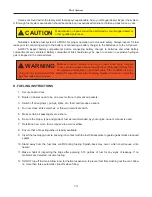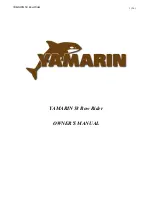
27
Your RangerTrail
®
Trailer
R:
Indicates a “radial” type tire.
15:
Indicates the wheel or rim diameter in inches.
Tire Ply Composition and Materials Used:
Indicates the number of plies or the number of rubber-coated fabric
in the tire tread and sidewall. Tire manufacturers also must indicate the ply materials in the tire and the sidewall,
which include steel nylon, polyester, and others.
Maximum Load Rating:
Indicates the maximum load in kilograms and pounds that can be carried by the tire. Refer
to the Certification Label on the port forward half of the trailer for the correct tire pressure for your trailer.
NOTICE: Manufacturer’s Tire Registry;
be sure to fill out the tire registration form provided with your owner’s
packet. Mail it to the tire manufacturer for the purpose of Federal defect notification regulations.
SAMPLE TIRE REGISTRATION
INFLATING YOUR TIRES
Safe operation of your trailer requires that your tires are properly inflated. Remember that a tire can lose up
to half of its air pressure without appearing flat. Before each trip, check your tires with a tire gauge, including the
spare (if equipped). Inflate all tires to the inflation pressure recommended on the Certification Label located on the
port side of the forward half of the trailer. Failure to follow the tire pressure recommendations can cause uneven
treadwear patterns and adversely affect the way your trailer handles.
Certification Label and Tire label
S A M PLE TIRE REGISTR ATIO N
Certification Label and Tire label
U nder-inflation is the mos t common caus e of tire failures and may res ult in
s evere tire cracking, tread s eparation or “blowout”, with unexpected los s of
vehicle control and increas ed ris k of injury. Under-inflation increas es
s idewall flexing and rolling resis tance, res ulting in heat buildup and
internal damage to the tire. It als o may res ult in unneces s ary tire stres s ,
irregular wear, los s of vehicle control and accidents . A tire can los e up to
half its air pres s ure and not appear flat!
A GE
Tires degrade over time, even when they are not being us ed. It is
recommended the tires generally be replaced after 6 years of normal s ervice.
Heat caus ed by hot climates or frequent high loading conditions can
accelerate the aging proces s . Yo u s h ould replace the s pare tire when you
replace the other tires due to the aging of the s pare tire.
Summary of Contents for RT Series
Page 20: ...18...








































